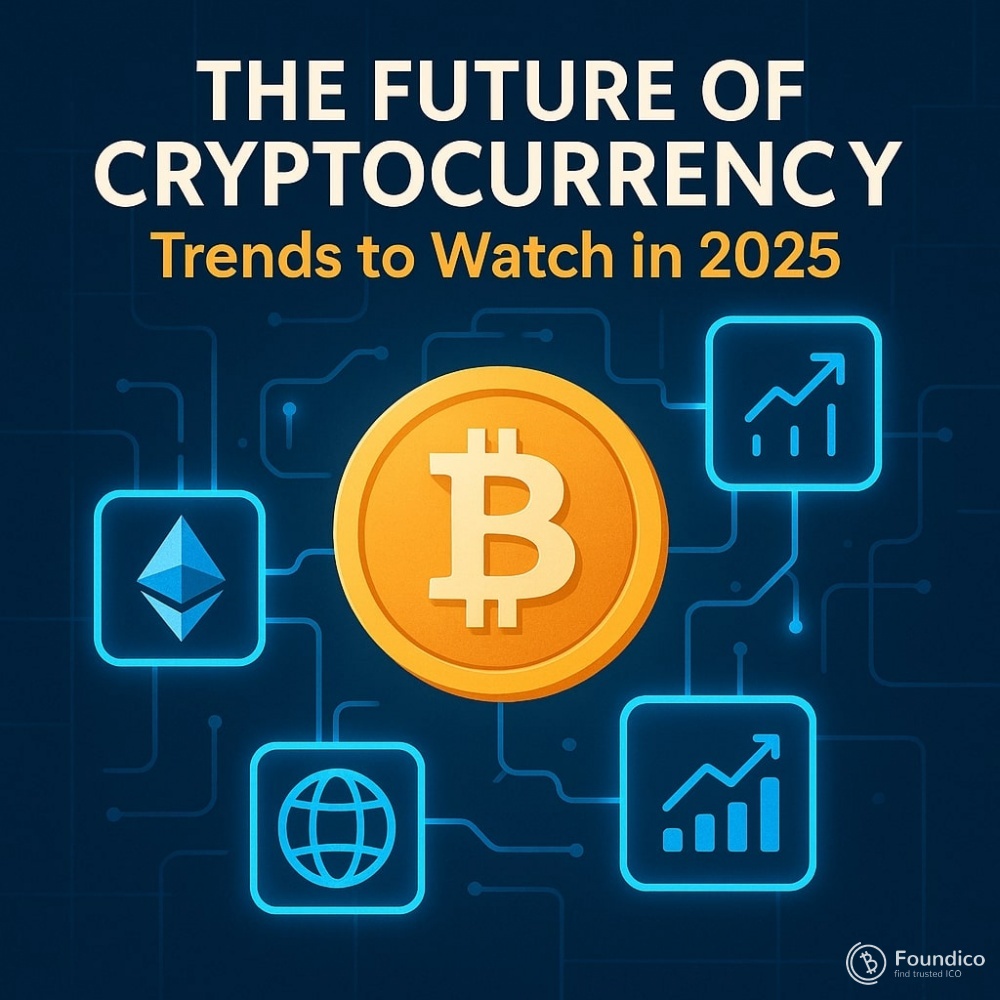The Future of Cryptocurrency: Trends to Watch in 2025

By Dr. Pooyan Ghamari, Swiss Economist and Visionary
Cryptocurrency has evolved at a breathtaking pace over the past decade—from a fringe experiment to a transformative force in global finance. As we approach 2025, the digital asset landscape is poised for a new phase of maturation, marked by technological innovation, regulatory evolution, and broader adoption. For investors, policymakers, and technology enthusiasts alike, understanding the emerging trends is critical to navigating the rapidly shifting cryptocurrency ecosystem.
Drawing upon my research and experience as a Swiss economist specializing in global financial innovation, this article highlights the key trends set to shape cryptocurrency’s future in 2025 and beyond.
1. Widespread Adoption of Central Bank Digital Currencies (CBDCs)
One of the most significant developments expected in 2025 is the acceleration of Central Bank Digital Currency projects worldwide. CBDCs represent government-backed digital currencies designed to complement or replace traditional cash.
-
By 2025, an increasing number of countries—especially emerging markets—will launch pilot programs or fully operational CBDCs.
-
CBDCs promise to improve payment efficiency, reduce costs, and enhance financial inclusion.
-
We will see deeper integration of CBDCs into international payment systems, fostering faster cross-border transactions and reducing reliance on correspondent banking.
The rise of CBDCs will fundamentally reshape monetary policy and how people interact with money, blending the benefits of digital currency with the stability of central bank backing.
2. DeFi Maturation and Regulation
Decentralized Finance (DeFi) platforms, which provide financial services without traditional intermediaries, have exploded in popularity. However, concerns around security, scalability, and regulatory compliance persist.
-
In 2025, expect DeFi platforms to mature, with improved smart contract security protocols and interoperability across blockchains.
-
Regulatory frameworks tailored for DeFi will emerge, balancing innovation with investor protection.
-
DeFi will increasingly integrate with traditional finance, creating hybrid ecosystems that leverage both decentralization and regulated oversight.
This maturation will expand DeFi’s user base beyond early adopters to mainstream finance.
3. Expansion of Web3 and Blockchain Utility
Cryptocurrency is increasingly linked to the broader Web3 movement—an internet powered by decentralized technologies.
-
In 2025, blockchain applications will extend far beyond currency, including decentralized identity systems, supply chain transparency, and digital rights management.
-
Non-Fungible Tokens (NFTs) will evolve from art and collectibles into practical use cases such as tokenized real estate, intellectual property rights, and gaming economies.
-
Layer 2 scaling solutions and new consensus mechanisms will reduce transaction costs and energy consumption, improving blockchain scalability.
These innovations will drive broader adoption of blockchain as an infrastructure technology.
4. Increased Institutional Involvement and Product Innovation
Institutional interest in cryptocurrency will deepen significantly in 2025.
-
Major banks, asset managers, and hedge funds will launch dedicated crypto investment products and services.
-
Regulatory clarity and custodial solutions will lower barriers for institutional participation.
-
New financial products like tokenized securities, crypto ETFs, and digital asset lending will diversify investment options.
This influx of institutional capital will increase market liquidity and reduce volatility over time.
5. Enhanced Focus on Sustainability and Energy Efficiency
Sustainability concerns around cryptocurrency mining, especially Proof of Work (PoW) systems like Bitcoin, have intensified.
-
In 2025, energy-efficient consensus mechanisms such as Proof of Stake (PoS) and newer hybrid models will dominate new blockchain networks.
-
Green mining initiatives and carbon offset projects will become standard practice.
-
Regulatory scrutiny on crypto’s environmental impact will drive innovation in eco-friendly blockchain technologies.
Sustainability will become a critical metric for cryptocurrency adoption and investment decisions.
6. Greater Regulatory Harmonization and Global Coordination
As cryptocurrency transcends borders, governments will recognize the need for international regulatory cooperation.
-
Expect more multilateral agreements addressing anti-money laundering (AML), taxation, and consumer protection.
-
Global standards for crypto auditing, reporting, and cybersecurity will be established.
-
Cross-border collaboration will mitigate risks such as fraud, illicit financing, and systemic market disruptions.
This trend toward harmonization will provide a more stable and predictable environment for crypto markets.
7. Rising Role of AI and Automation in Crypto Markets
Artificial intelligence (AI) and automation technologies will increasingly intersect with cryptocurrency markets.
-
AI-driven trading algorithms will become more sophisticated, improving market efficiency and liquidity.
-
Automated compliance tools will streamline regulatory reporting and fraud detection.
-
AI will aid in smart contract verification and blockchain analytics, enhancing security and transparency.
The integration of AI will propel crypto markets into a new era of data-driven sophistication.
The future of cryptocurrency in 2025 is bright but complex. Rapid technological advancements, growing regulatory frameworks, and expanding institutional participation will transform the digital asset landscape into a more mature, secure, and inclusive financial ecosystem.
As a Swiss economist focused on innovation, I believe the trends outlined here will collectively propel cryptocurrency from experimental technology toward becoming a foundational pillar of the global financial system. Stakeholders—from policymakers to investors—must stay informed and adaptable to seize the opportunities and mitigate the risks ahead.
Dr. Pooyan Ghamari is a Swiss economist and visionary specializing in the intersection of emerging technologies and global finance. He advises international organizations on cryptocurrency economics and digital innovation strategies.
